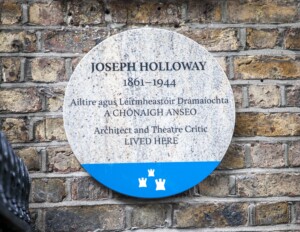Dublin City Council has today unveiled a commemorative plaque remembering Joseph Holloway (1861–1944), Architect and Theatre Critic, who designed the first Abbey Theatre.
Born in Camden Street, where his father had a bakery, Holloway was educated at St Vincent’s in Castleknock.
Following the death of his father, in 1874, the family moved to 21 Northumberland Road, where Holloway lived until his death in 1944.
After studying at the Dublin School of Art, in 1890 he joined O’Callaghan architects, in Kildare Street, Dublin, and after 6 years he began working for himself in 1896.
Holloway’s most famous work was the remodelling of the Mechanics’ Institute and Theatre on Lower Abbey Street as the first Abbey Theatre, which opened in December 1904.
He gave up architecture after the First World War, and, having a private income, he was able to devote himself to the theatre.
A great supporter of the Irish Literary Theatre and then Irish National Theatre, he attended almost all rehearsals and first nights.
Over his lifetime he accumulated a vast collection of material relating to Irish theatre, which adorned every inch of his house, including programmes, playbills, prompt sheets, and paintings and sketches of theatrical personalities.
More significantly, he kept a diary or journal which amounted to 25 million words on Dublin’s theatre world.
Although criticised by the likes of Sean O’Casey and Frank O’Connor, the diaries are an invaluable source for the history of Irish theatre.
Holloway died in 1944 and his huge archive was donated to the National Library of Ireland where it is catalogued as the Joseph Holloway Collection.

Speaking at the unveiling of the plaque at 21 Northumberland Road, Councillor Dermot Lacey, representing the Lord Mayor said, “A great supporter of the Irish Literary Theatre and then Irish National Theatre, Holloway left this house here on Northumberland Road, to attend almost all rehearsals and first nights.
“Taking the tram, he would have had a choice of the number 6, 7, or 8, all going to the Pillar, and then a short walk down Abbey Street to the theatre.
“It’s great to see the continuity in the cultural life or our city – notwithstanding all that has changed – in that people, all these years later, continue to make the short, or longer, journey to Abbey Street, to attend the performances put on by our national theatre, the Abbey.”
The proposal to commemorate Joseph Holloway was made by Nuala Holloway, who said, “Joseph Holloway was undoubtedly one of the most devoted playgoers the world has ever seen.
“From the 1880s until his death in 1944 he attended practically every first night in his native city of Dublin.
“As architect of the Abbey Theatre he was intimately involved in the Irish Dramatic Renaissance along with W.B. Yeats, Lady Gregory and others.
“Fortunately his great wealth of knowledge has not been lost.
“His writings along with other historical material are kept in the Holloway Collection in the National Library, Dublin which are an invaluable source of material for writers and researchers.”
The decision to erect the plaque was made by the Dublin City Council Commemorations & Naming Committee, whose chair, Councillor Micheál Mac Donncha, said, “The Commemorative Plaques Scheme allows the City to formally commemorate people who have made a significant contribution to the life of Dublin.
“We welcome suggestions from the public for people and events to be commemorated, and full details are on the Council website.”